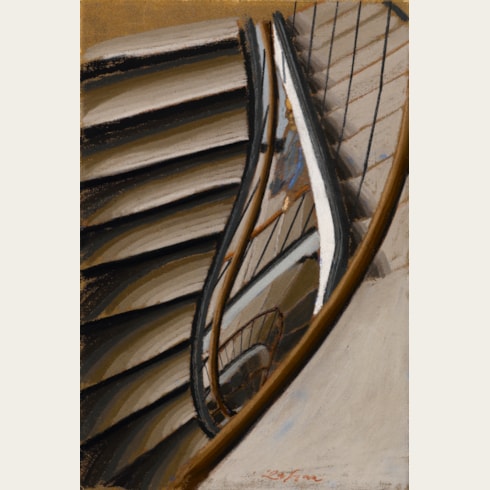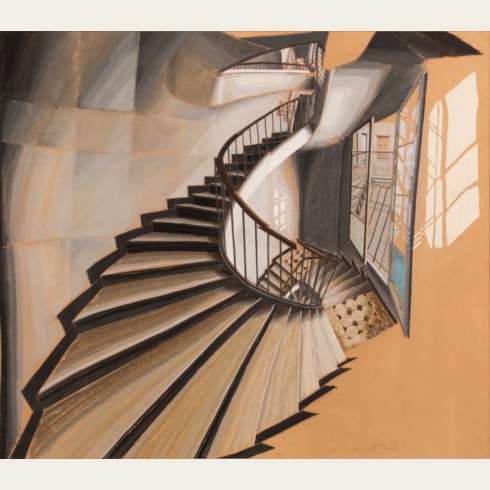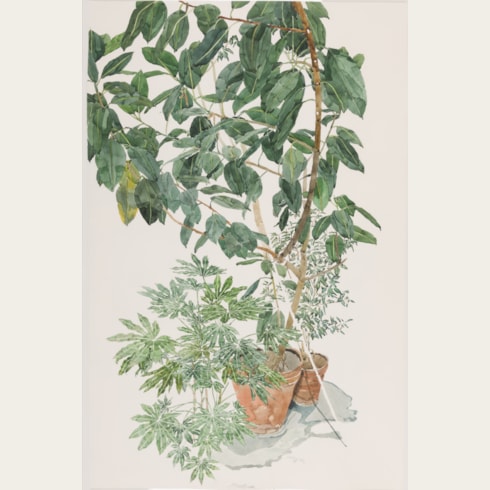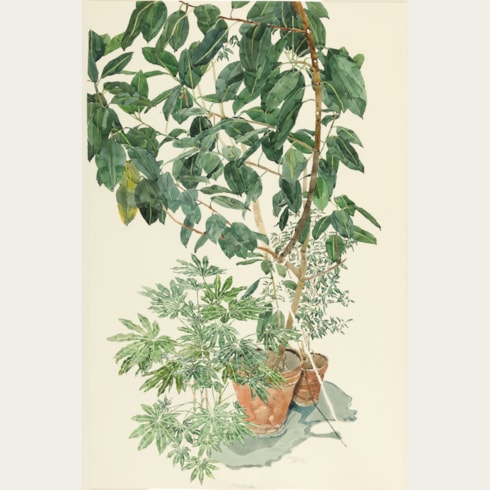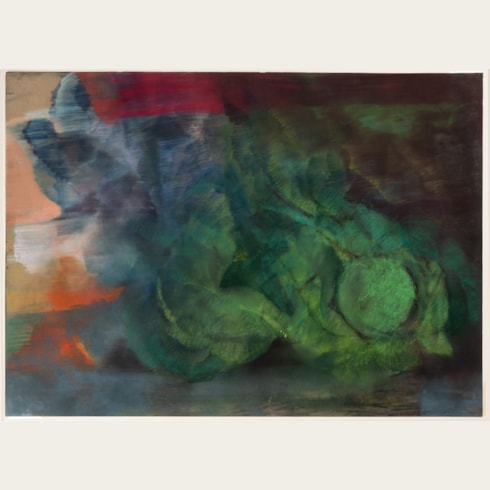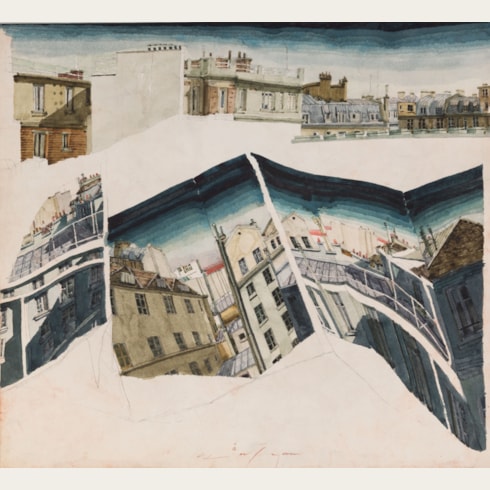Sam SZAFRAN
(Paris 1934 - Paris 2019)
The Staircase at 54, rue de Seine, Paris
Sold
Watercolour on silk.
Signed Szafran at the lower right.
172 x 471 mm. (6 3/4 x 18 1/2 in.)
Signed Szafran at the lower right.
172 x 471 mm. (6 3/4 x 18 1/2 in.)
Drawn in 1991, the watercolour depicts one of Szafran’s favourite subjects, the staircase in the apartment building at 54 rue de Seine in Paris, seen from above in steep perspectival foreshortening. Szafran began making pastel drawings and photographs of the spiral staircase in the 1960’s, studying it from multiple viewpoints and attempting to capture something of the sense of vertigo one felt when looking down the stairwell from a high floor. He returned to the theme in the 1990’s in such works as the present sheet, painted in watercolours on Chinese silk. These later works are largely based on his photographs and memories of the escalier, and in many of them the staircase seems to float in space, and at times becoming even more abstract in conception, flattened out and spread open like a fan. Sometimes just the balustrade remains, curving and twisting into the centre of the composition.
Szafran has described the origin of this motif in his work: ‘One evening I was working in this staircase – I’ve always lived in stairwells – and I fell asleep. It was night and I had a nightmare. I woke up and it was the full moon. There was a shadow falling from the window onto the steps of the staircase. I saw it suddenly – I had passed by a thousand times without seeing it and suddenly I noticed it, so I decided to draw it. But the shadow moved every three minutes...the earth turns...There was a slice of light here, while everywhere else was dark. I drew by the light of a flashlight until everything became dark. At one point, everything that had been very dark became light and everything light became dark. To create the whole, I had to keep moving. I was forced to identify myself with a spider, who ascends and descends the end of his thread.’
As the artist’s friend James Lord has described these works, ‘Plunging views of vertiginous staircases repeated sometimes again and again on the same sheet with shifting, dizzying variations in points of view, intense but fastidious in color, nearly supernatural in the cadenza virtuosity of execution, verging almost upon abstraction though never quite letting slip the desperate affirmation of a specific subject matter, within which we can occasionally make out, as if glimpsed sidelong in the galactic swirl, the tiny, lovely, fragmentary semblance of a human being. Staircases that begin nowhere and lead everywhere, start from nothing and end in everything, where descending is forever ascending and the fullness of emptiness is dense as a white dwarf. Spirals of stair railings tracing the continuum eked out of invisible space which nonetheless balloons beneath coffered skylights and out of windows bluer than the sky…Szafran’s staircases…are the output of an eye dedicated to the absolutism of its own experience, disciplined by self-effacement before what sight alone can convey to the senses but submissive at the same time to the sublimating want of self-expression…Seeing Szafran shows how wonderfully well looking can think.’
Szafran has described the origin of this motif in his work: ‘One evening I was working in this staircase – I’ve always lived in stairwells – and I fell asleep. It was night and I had a nightmare. I woke up and it was the full moon. There was a shadow falling from the window onto the steps of the staircase. I saw it suddenly – I had passed by a thousand times without seeing it and suddenly I noticed it, so I decided to draw it. But the shadow moved every three minutes...the earth turns...There was a slice of light here, while everywhere else was dark. I drew by the light of a flashlight until everything became dark. At one point, everything that had been very dark became light and everything light became dark. To create the whole, I had to keep moving. I was forced to identify myself with a spider, who ascends and descends the end of his thread.’
As the artist’s friend James Lord has described these works, ‘Plunging views of vertiginous staircases repeated sometimes again and again on the same sheet with shifting, dizzying variations in points of view, intense but fastidious in color, nearly supernatural in the cadenza virtuosity of execution, verging almost upon abstraction though never quite letting slip the desperate affirmation of a specific subject matter, within which we can occasionally make out, as if glimpsed sidelong in the galactic swirl, the tiny, lovely, fragmentary semblance of a human being. Staircases that begin nowhere and lead everywhere, start from nothing and end in everything, where descending is forever ascending and the fullness of emptiness is dense as a white dwarf. Spirals of stair railings tracing the continuum eked out of invisible space which nonetheless balloons beneath coffered skylights and out of windows bluer than the sky…Szafran’s staircases…are the output of an eye dedicated to the absolutism of its own experience, disciplined by self-effacement before what sight alone can convey to the senses but submissive at the same time to the sublimating want of self-expression…Seeing Szafran shows how wonderfully well looking can think.’
Born Samuel Berger in 1934 to Polish Jewish immigrants and raised in the area of Les Halles in Paris, Sam Szafran was imprisoned as a child at the Drancy internment camp, northeast of the city, during the Occupation. Following the Liberation he lived for some years with his mother and sister in Australia before returning to Paris in 1951, at the age of seventeen. He attended evening drawing classes and became friendly with a number of artists, including Jean Arp, Henri Cartier-Bresson, Yves Klein, Joan Miro and Jean-Paul Riopelle, as well as Alberto Giacometti. Although he was briefly enrolled at the Académie de la Grande-Chaumière in Paris in the mid-1950s, Szafran was largely self-taught as an artist. He took the maiden name of his mother when he began to sign his works, and exhibited at the Salon des Indépendants in 1957 and the Salon des Réalités Nouvelles two years later. While his earliest works were based in abstraction, from around 1960 onwards he began to depict representational subjects, drawn in pastel or charcoal and, from the late 1970s onwards, watercolour. Content with studying a limited range of themes - notably studio interiors, staircases and plant forms - he produced numerous drawings, each characterized by a very skillful handling of the medium and an abiding interest in perspectival effects. From 1965, when Szafran had his first solo exhibition, his work was exhibited extensively in France, and also in Switzerland, but only rarely elsewhere. Szafran contributed to the Nouvelle Subjectivité exhibitions curated by Jean Clair in Paris in 1976 and in Brussels in 1979. Throughout much of the artist’s career, his work was acquired by a coterie of enthusiastic and devoted collectors.
A retrospective exhibition of drawings, pastels, watercolours and sculptures by Szafran was held at the Fondation Pierre Gianadda in Martigny and the Fondation Maeght in Saint-Paul de Vence in 1999-2000. Later exhibitions followed at the Max Ernst Museum in Brühl in 2010-2011 and at the Fondation Gianadda in 2013. Following Szafran’s death in 2019, a large commemorative exhibition at the Musée de l’Orangerie in Paris in 2022-2023 drew some 330,000 visitors. In 2015 a permanent gallery devoted to Szafran’s work was established at the Fondation Gianadda in Martigny in Switzerland, while other works by the artist are today in the collections of the Metropolitan Museum of Art and the Museum of Modern Art in New York, the Centre National d’Art Contemporain, the Musée d’Orsay and the Musée d’Art Moderne in Paris, the Hirshhorn Museum and Sculpture Garden in Washington, D.C., the Musée Cantini in Marseille, and elsewhere.
A retrospective exhibition of drawings, pastels, watercolours and sculptures by Szafran was held at the Fondation Pierre Gianadda in Martigny and the Fondation Maeght in Saint-Paul de Vence in 1999-2000. Later exhibitions followed at the Max Ernst Museum in Brühl in 2010-2011 and at the Fondation Gianadda in 2013. Following Szafran’s death in 2019, a large commemorative exhibition at the Musée de l’Orangerie in Paris in 2022-2023 drew some 330,000 visitors. In 2015 a permanent gallery devoted to Szafran’s work was established at the Fondation Gianadda in Martigny in Switzerland, while other works by the artist are today in the collections of the Metropolitan Museum of Art and the Museum of Modern Art in New York, the Centre National d’Art Contemporain, the Musée d’Orsay and the Musée d’Art Moderne in Paris, the Hirshhorn Museum and Sculpture Garden in Washington, D.C., the Musée Cantini in Marseille, and elsewhere.





